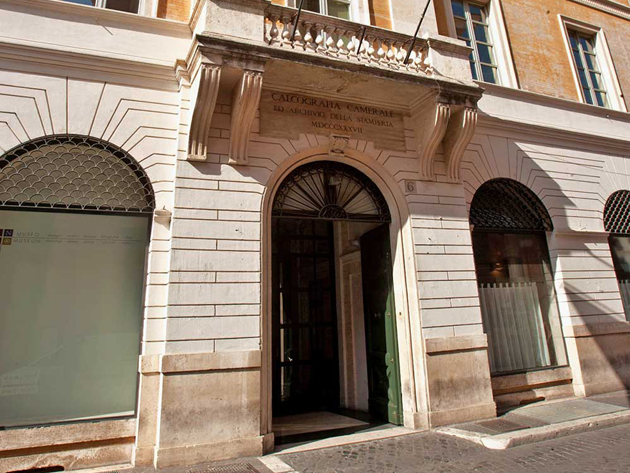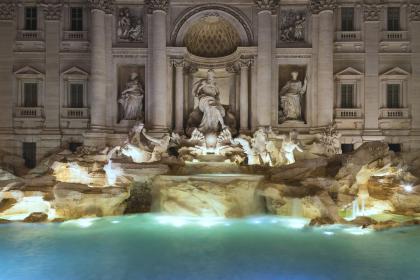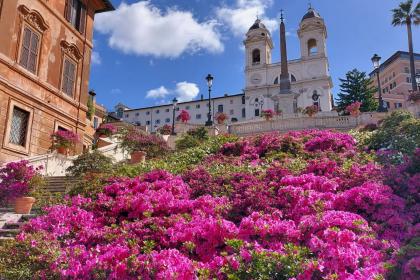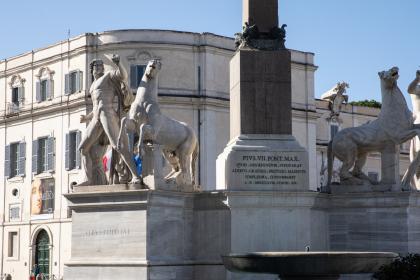
The Central Institute for Graphics is hosted inside the monumental complex of the Trevi Fountain and includes Palazzo Poli and the adjoining Palazzo della Calcografia, built in 1837 by the architect Giuseppe Valadier to house the Chamber of Chalcography, of which he was director for decades.
This museum has the task of preserving, protecting and promoting a heritage of works about graphic art in all its forms: the collections of matrices, prints, drawings, artist videos and photographs are supported by specialized restoration and by a printing house of centuries-old experience.
Its constitution dates back to 1883 when Prince Tommaso Corsini sold his Palace and the related Pinacoteca to the State, also donating the Library to the Accademia dei Lincei which, to ensure the consultation and conservation of the collection of prints and drawings, entrusted it, in turn, in permanent deposit to the State. For this purpose, the National Prints and Drawings Department was established.
The current Fund was made up of the initial nucleus of the Corsini Fund, to which other collections have been added such as the eighteenth-century Fondo Pio, the Fuga Fund, the Drusiani Fund, which includes a large collection of Tiepolo's prints; for a total of 150 thousand pieces including prints and drawings.
Palazzo Poli was purchased by the Italian state in the 1970s to unify the National Chalcography and the National Prints and Drawings Department, merged into the current Institute.
The building, on which the building of the Trevi Fountain rests, was commissioned by Lelio dell’Anguillara, Duke of Ceri who, in 1566, had bought the pre-existing Del Monte palace and is the result of different construction phases. The works were carried out on a project by the architect Martino Longhi the Elder in 1573 and, on his death, by Ottaviano Mascherino. Its walls, in the 19th century, hosted several illustrious tenants, including the painters Francesco Manno and Joseph Severn, the poets Peter Cornelius and Giuseppe Gioachino Belli, who composed many of his Roman sonnets here.
From 1834 it became the residence of Princess Zenaide Wolkonsky, who hosted Belli himself and the Russian novelist Nikolai Vasil'evič Gogol 'in her literary salon. The most evocative place in the Palazzo is the Dante Room, known for its large size. Built in the eighteenth century to house the library of the Duke of Poli, it was also used as a party room. Currently, events, conferences, concerts, seminars are held inside Palazzo Poli; while on the first floor there are the exhibition spaces that host exhibitions and displays of historical and contemporary graphics.
The Chalcography Palace, characterized by the sober neoclassical façade by Valadier, preserves an extensive intaglio collection that originates from the collection of the De Rossi, a family of printers operating in the Roman environment of the seventeenth century. This collection, which had already merged other of the most important Roman publishers of the 16th century, was purchased in 1738 by the Papal State which established the Chamber Chalcography. Became Regia in 1870 and National with the birth of the Republic, the collection contains 23,000 matrices ranging from the sixteenth to the twentieth century; in addition to the De Rossi Fund, the Canova, Camuccini, Volpato, Carrà and Morandi funds are present; there are also two thousand copper plates by great engravers such as Piranesi and Ingres. The palace exhibits prints, engraving tools, machinery and ancient presses. The printing house, although not carrying out a continuous activity as in the past, is still active.
The National Institute for Graphics owns two libraries: that of Chalcography, founded in 1905, and that of the Drawings and Prints Cabinet established in 1895.
The volumes kept in both are about 7,000 and include publications ranging from the end of the eighteenth century to the present day, as well as the sales catalogs of the ancient Stamperia De Rossi. The collection includes texts on the history of drawing and engraving, many essays on the history of art and exhibition catalogs; there are also monographs, technical manuals on the graphic techniques, volumes dedicated to photography and encyclopedias.
The Trevi Fountain

 Condividi
Condividi
The most famous of the Roman fountains: a jewel of water and stone
Piazza di Spagna

 Condividi
Condividi
The Scuderie del Quirinale

 Condividi
Condividi
Information
For the opening times and guidelines please check the official website.
 Condividi
Condividi
Location
To find out about all accessibility services, visit the Rome accessible section.











































